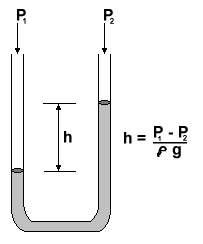The Manometer

Figure illustrates a manometer consisting of a U-tube, the two arms of which are associated to two systems in which the pressures are p1 and p2. The aim of the manometer is to give a measure of the difference among p1 and p2. The lower part of the U-tube is filled with a liquid having density that greatly exceeds the densities of the fluids in the two systems. The vertical distance z dividing the two free liquid surfaces is measured by means of a properly supported scale.
From the principles of hydrostatics, the density, pressure and height difference are associated by:
(p1 – p2) = ρ gz
Knowing ρ, measurement of z allows the pressure difference (p1 − p2) to be computed. Additionally, when p2 is known, p1 can be established.
It is fascinating to note that the two arms of the U-tube require not be of equivalent, or even of uniform cross-sectional area.
Example:
Compute the pressure difference in Pa equivalent to 1 mm difference in liquid surface level in a manometer if the liquid is: (i) water, (ii) mercury, acquire the densities of water and mercury to be 1000 and 13568 kg/m3; and the gravitational acceleration to be 9.81 m/s2.
Solution:
(p1 – p2) = ρ gz
(a) For water, (p1 – p2) = 1000 kg/m3 × 0.001 m × 9.81 m/s2 = 9.81 Pa
(b) For mercury, (p1 – p2) = 13568 kg/m3 × 0.001 m × 9.81 m/s2 = 133.1 Pa